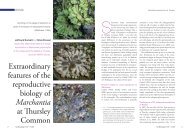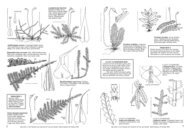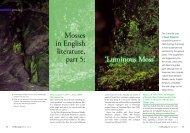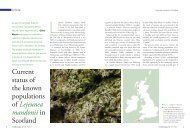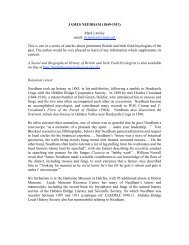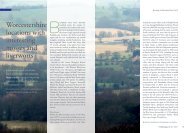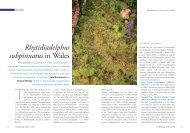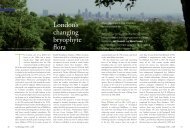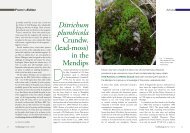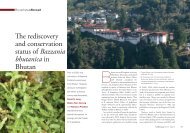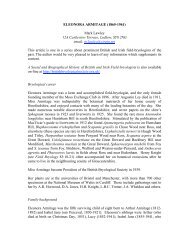WILLIAM VERNON (1666/7-1715) Mark Lawley email: m.lawley ...
WILLIAM VERNON (1666/7-1715) Mark Lawley email: m.lawley ...
WILLIAM VERNON (1666/7-1715) Mark Lawley email: m.lawley ...
Create successful ePaper yourself
Turn your PDF publications into a flip-book with our unique Google optimized e-Paper software.
<strong>WILLIAM</strong> <strong>VERNON</strong> (<strong>1666</strong>/7-<strong>1715</strong>)<br />
<strong>Mark</strong> <strong>Lawley</strong><br />
<strong>email</strong>: m.<strong>lawley</strong>@virgin.net<br />
This is one in a series of articles about prominent British and Irish field-bryologists of the<br />
past. The author would be very pleased to learn of any information which supplements its<br />
content.<br />
A Social and Biographical History of British and Irish Field-bryologists is also available<br />
on-line at http://britishbryologicalsociety.org.uk/<br />
Botanical career<br />
Vernon became interested in mosses and Lepidoptera while at Cambridge in the late 17 th<br />
century, and became friendly with John Ray in 1694. He assisted Ray with his account<br />
of cryptogams in Historia Plantarum (three volumes, 1686, 1688 and 1704). Ray wrote<br />
to Edward Lhwyd in 1694, commending Vernon’s efforts in collecting mosses, saying<br />
that he had “been more industrious in searching out and more successful in finding the<br />
species of that tribe than any man I know…. He hath communicated to me dried samples<br />
of many sorts which I had not discovered and shown me more”.<br />
Vernon also knew James Petiver, who described him in Musci Petiveriani Centauria<br />
Prima (1695) as a man “who hath been very curious in the discovery of this minute Tribe<br />
of Plants”.<br />
He was a member of a botanical club that met at the Temple Coffee House in London<br />
between 1689 and 1706, whose other members included Adam Buddle, Nehemiah Grew,<br />
Martin Lister and Hans Sloane.<br />
Some of the plants that Vernon collected are in the Sloane herbarium in the Natural<br />
History Museum, London. He corresponded with Ray, Petiver, Sloane, Richardson,<br />
Lhwyd and others, and many of these letters remain extant.<br />
Family background and biography<br />
William Vernon was one of seven children born to William Vernon (died c.1685-90),<br />
Esquire, gentleman of Hertingfordbury, Hertfordshire, and Anne (née Fitzherbert). His<br />
father’s and mother’s families were both landowning gentry.<br />
Anne was a daughter of John Fitzherbert (died 1661), Esquire, of Begbroke and<br />
Kiddington, Oxfordshire, whose own father Humphrey (1551-1617) of Begbroke was in<br />
turn a son of John Fitzherbert of Uphall, Hertfordshire by his second wife Anne (née<br />
Wenman). Anne Wenman was a daughter of Thomas Wenman (born c.1507) of Twyford
in Buckinghamshire and Carswell, Oxfordshire. Thomas Wenman married Ursula<br />
Gifford (c.1509-1558), whose great-great grandparents were Thomas Gifford (1408-<br />
1469) and Eleanor (née Vaux); they were 17 times great-grandparents of Diana, Princess<br />
of Wales (1961-1997). The Giffords held land at Twyford, Buckinghamshire in the 13 th<br />
and 14 th centuries, Brimfield in Gloucestershire since before the Norman Conquest, and<br />
numbered among their ancestors John Gifford (1232-1299), baron and 1 st Lord Gifford of<br />
Brimfield (see Dictionary of National Biography), as well as William the Conqueror’s<br />
sister Godiva of Normandy, and Robert “The Devout” Fitzharding (c.1095/6-1171), a<br />
burgess and merchant of Berkeley and Bristol (see DNB).<br />
On his father’s side of the family, William Vernon’s father William was in turn a son of<br />
Francis Vernon, Esquire, of Hertingfordbury and Eleanor (née Cockain or Cockaine,<br />
1614), daughter of William Cockain (or Cockaine, Cockraine, Cokaine, died 1642/3),<br />
merchant of London and a governor of the East India Company. He in turn may have<br />
been related to Sir William Cockaine (died 1627) of Combe, Surrey. Francis Vernon was<br />
a son of Christopher Vernon (fl. 1642), Esquire, of Hertingfordbury, Controller of the<br />
Pipe, by his second wife Susannah (née Lawrence), daughter of Roger Lawrence, gent.<br />
William’s elder brother Christopher (1663/6-?1724) became Comptroller of the Pipe<br />
Office of the Exchequer (as his paternal grandfather had been before him), but sold the<br />
family estate of Hertingfordbury in 1690, and seems to have emigrated to Herring Creek<br />
in Maryland, America. Christopher Vernon, planter of Maryland died in 1724.<br />
William’s other siblings were John, Thomas, Eleanor (who married Francis Shrimpton,<br />
goldsmith of London), Elizabeth and Mary.<br />
William received his early education at the public school of Hertford, whence he went up<br />
to Peterhouse College, Cambridge in April 1685. He graduated B.A. in 1689, and<br />
became a fellow of the college in 1692.<br />
By the mid-1690s Vernon was in touch with other naturalists such as John Ray and James<br />
Petiver, and in 1697/8, having procured a four-year leave of absence from Peterhouse<br />
College, he sailed to Maryland (where his elder brother Christopher had settled) for the<br />
purpose of collecting plants, animals, fossils and shells for the Royal<br />
Society and his friends at the botanical club. In the event, Vernon returned to England in<br />
late 1698, and almost immediately planned a trip to the Canaries, but despite obtaining<br />
funding from the Royal Society, Vernon got no further than the coast of Kent.<br />
Vernon returned to Cambridge in 1702. Hardly anything is known of his later years, and<br />
nothing of when or where he died.



